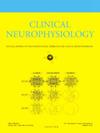头皮脑电图对皮层慢电位的自我调节和癫痫抑制:治疗效果的早期预测。
IF 3.7
3区 医学
Q1 CLINICAL NEUROLOGY
引用次数: 0
摘要
目的:应用脑皮层慢电位(SCP)自我调节的神经反馈(NFB)方法抑制难治性局灶性癫痫的发作是有效的。然而,所需的长期培训时间阻碍了它作为临床实践中的标准治疗的广泛实施。因此,尽管患者数量较少,我们还是研究了缩短培训时间是否合适。方法:12例患者参加NFB培训。1期NFB训练共35节,分为2个阶段。每个阶段结束后,我们评估每位患者是否获得NFB控制,并评估与训练前相比癫痫发作减少情况。结果:11例完成第一期训练的患者中,4例训练后癫痫发作频率降低,其中3例可以调节SCP极性(NFB控制)。在剩下的7人中,2人在第二训练阶段获得了NFB控制,但癫痫发作频率没有下降。此外,其他5例未获得NFB控制,癫痫发作频率未降低。结论:在短时间内(即3周)获得NFB控制的患者更有可能表现出较低的训练后癫痫发作频率。意义:SCP自我调节可在短时间内获得,并与癫痫发作减少有关。本文章由计算机程序翻译,如有差异,请以英文原文为准。
Self-regulation of slow cortical potential and seizure suppression by scalp electroencephalography: Early prediction of therapeutic efficacy
Objective
Seizure suppression using the neurofeedback (NFB) method by self-regulation of scalp-recorded slow cortical potential (SCP) is effective for patients with refractory focal epilepsy. However, the prolonged training period required prevents it from wider implementation as the standard treatment in clinical practice. Therefore, we examined whether it would be appropriate to shorten the training period, in spite of the small number of patients.
Methods
12 patients participated the NFB training. 1 course of NFB training consisted of 35 sessions divided into 2 phases. After each phase we evaluated whether each patient acquired NFB control, and seizure reduction was assessed compared to that before training.
Results
Of 11 patients who completed the first training phase, 4 showed reduced post-training seizure frequency, of whom 3 could regulate the SCP polarity (NFB control). Of the remaining 7, 2 acquired NFB control during the second training phase but seizure frequency did not decrease. Furthermore, the other 5 did not acquire NFB control, and seizure frequency did not decrease.
Conclusions
Patients who acquired NFB control within a short period, i.e., 3 weeks, were more likely to exhibit a lower post-training seizure frequency.
Significance
SCP self-regulation can be acquired within a short period and is associated with seizure reduction.
求助全文
通过发布文献求助,成功后即可免费获取论文全文。
去求助
来源期刊

Clinical Neurophysiology
医学-临床神经学
CiteScore
8.70
自引率
6.40%
发文量
932
审稿时长
59 days
期刊介绍:
As of January 1999, The journal Electroencephalography and Clinical Neurophysiology, and its two sections Electromyography and Motor Control and Evoked Potentials have amalgamated to become this journal - Clinical Neurophysiology.
Clinical Neurophysiology is the official journal of the International Federation of Clinical Neurophysiology, the Brazilian Society of Clinical Neurophysiology, the Czech Society of Clinical Neurophysiology, the Italian Clinical Neurophysiology Society and the International Society of Intraoperative Neurophysiology.The journal is dedicated to fostering research and disseminating information on all aspects of both normal and abnormal functioning of the nervous system. The key aim of the publication is to disseminate scholarly reports on the pathophysiology underlying diseases of the central and peripheral nervous system of human patients. Clinical trials that use neurophysiological measures to document change are encouraged, as are manuscripts reporting data on integrated neuroimaging of central nervous function including, but not limited to, functional MRI, MEG, EEG, PET and other neuroimaging modalities.
 求助内容:
求助内容: 应助结果提醒方式:
应助结果提醒方式:


